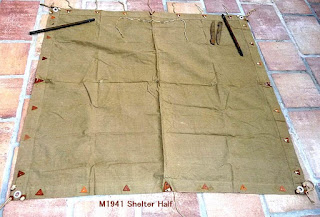While I was researching aspects of
reducing the soldier’s load the WW2 Japanese Army often came up. Of particular
interest was this in-depth article on the evolution of the Japanese soldier’s
shelter cloth. I have taken the liberty of reproducing some of the
illustrations from that article below.
According to the 1944 Handbook on Japanese Military Forces (TM-E 30-480):
“Cotton raincoats with hoods are issued
to Japanese troops, but in most theaters they prefer to use the shelter half as
rain protection.” and “As a raincape
it provides excellent protection against wetness and is preferred by many
Japanese soldiers to the issue raincoat. A cord is attached to the middle of
one end so that the shelter half can be suspended from the shoulders and tied
under the chin. Loops through the eyelets on one of the sides then may be
slipped through the eyelets on the opposite side to close it securely in front.
Two of the corners rest approximately elbow high, allowing the arms freedom of
movement. The shelter half also is used as a ground sheet, or to roll up in for
protection in a foxhole. It can be pitched as a tent, either alone or in combination
with varying numbers of others.”
The method of joining the cloths together
with the cord loops is rather elegant and ingenious. Apparently this was also
used when the cloth was worn as a garment. Below is an illustration I have in
another book. Interesting here is that the cloth appears to be a 3:4 rectangle
rather than a square.
The Books






